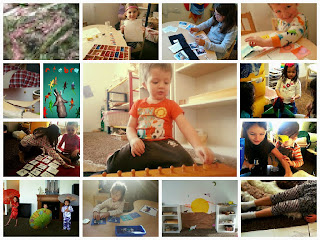These days innovation and technology are a hot subject-- and it is no secret that some of the most prominent creative minds, such as the founders of
Google, Sergey Brin and Larry Page, or Amazon's founder Jeff Bezos
credit their Montessori foundation for their ability to generate innovative solutions and think creatively. In fact, many creative and bright minds in the fields of technology, art, poetry, science, credit their Montessori sensorial and stereognostic experiences during their early childhood as fundamental to their creative development. Such people include Thomas Edison, Alexander Graham Bell, Hellen Keller, Henry Ford, Mahatma Gandhi, to name a few. What could be the link between creativity, problem solving, and Montessori? The answer is found in the brilliant Montessori sensorial works.
 |
| Patterning with the sensorial and number rods to make a maze. This requires precision, problem solving (what do you combine to continue the pattern after the side is longer than the longest rod?). The children noticed this was the shape of a shell, a race track, the Mayan symbol for water, or the hypnoryzing eyes of a snake from a favorite cartoon. |
The Montessori Sensorial works come from the word sense or senses. These works are made to help the child hone his sensibilities. Such exercises create a wonderful net of neurological connections that can pave the way for future problem solving, and can remain for life. People who have developed such gray matter networks as young children can use that capacity later in life to tackle new situations, conceptualize possibilities, and find creative solutions. Montessori sensorial exercises are divided in the categories of visual, tactile, baric, thermic, auditory, olfactory, gustatory and sterognostic (the ability to determine the shape of an object by touch or lifting it).
As children use the sensorial works in our class, they will gradually focus and sharpen each of their senses. These works are fun and enjoyable challenges that capture not only the minds, but the hands, eyes, noses, and senses of the child as a whole.
 |
| A child uses 10 blocks in each set to compare how the minor differences in height, with, or length result in notable differences in the towers that can be built |

|
| A child uses 10 cubes from 1cm to 10 cm, along with a 10 brown prisms of the same length but differing in height, to build a structure. |
 |
| The child uses the same pink cubes and brown prisms to explore a different structure. |

|
| A child builds a tower, realizing that for stability, the biggest blocks must come first. |
 |
A child explores how the differences in density between a marble and a pompom result in different speeds.
|











Comments
Post a Comment